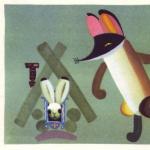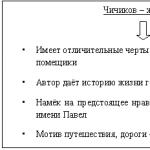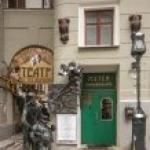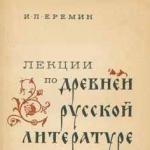The author's image in dead souls is brief.
The image of the author in the poem by N.V. Gogol's "Dead Souls"
Since the genre of the poem presupposes the equality of the lyrical and epic principles, it is impossible to do without the author’s word in this work. The lyrical beginning in the poem “Dead Souls” is realized precisely in the author’s digressions.
Although not the hero of the poem, the author of “Dead Souls” appears in it as a lyrical hero. The reader gets an idea of the lyrical hero by analyzing Gogol’s literary views and thoughts about the chosenness of the writer, about two types of writers, about two types of portraits, about the language of a work of art, about the choice of the main character.
The author shares his creative ideas with the reader: “And this is how this strange plot was formed in the head of our hero, for which I don’t know whether the readers will be grateful to him, and how grateful the author is, it’s difficult to express. For, no matter what you say, if this thought had not occurred to Chichikov, this poem would not have been born.” The author talks with the reader about his positive ideal, talks about his attitude towards Chichikov Topic No. 61. The image of the author in the poem by N.V. Gogol’s “Dead Souls”: Preparing for an essay / Literature. - No. 7. - 2001..
The author constantly communicates with the reader, and his attitude towards the reader often reveals irony, hidden under the desire to please. This is how Gogol addresses the lady readers: “The ladies will not like him [Chichikov], this can be said in the affirmative, for the ladies demand that the hero be absolutely perfect...” The author of the poem is trying to predict the reader’s attitude towards the main character, to imagine the reader’s possible reaction.
The author also acts as a narrator in his lyric-epic work. Some of his statements connect individual episodes of the poem and play an important compositional role: “... It’s time for me to return to our heroes, who have been standing for several minutes in front of the living room doors, mutually asking each other to go forward.” Other statements by the author connect individual episodes or lyrical digressions with the main narrative.
The relationship between the lyrical and epic principles in the poem is a means of expressing the author’s position.
Generalizing digressions associated with the epic part reveal the author’s attitude towards the heroes. The author's position is also expressed through the perception of Chichikov. Sometimes it is difficult to separate Chichikov's thoughts from lyrical digressions.
Belinsky was ambivalent about Gogol’s “pathos of subjectivity.” He appreciated many lyrical digressions. Let's talk about the sad fate of a realist who, with his works about the difficult situation of the country, evokes the hatred of the secular “rabble.” Or - digressions, remarks, remarks (such as: “Eh, the Russian people! They don’t like to die a natural death!”) in defense of the people. The critic called this kind of author’s reflection “humane subjectivity.” At the same time, he rightly doubted the possibility (declared already in the first volume of the poem) of finding real prototypes of a “husband gifted with divine virtues” and an equally ideal “maiden”: “so much has been promised that there is nowhere to take what to fulfill the promise.”
One cannot but agree with this judgment. However, one cannot ignore the logic of the writer’s creative quest. After writing Volume I, he felt the need to express his ideals in their entirety. The author's experiences at the sight of social vices required a balanced depiction of harmonious relationships. For this purpose, volume II of the poem Russian Literature is being created. Soviet literature. Reference materials. - M.: Mysl, 1989. P. 63-65..
In Nikolai Vasilyevich Gogol’s poem “Dead Souls”, along with the main characters: its main character Chichikov, landowners and officials, another important character takes part - the author. At the same time, we cannot say that the author is an image completely identical to Gogol himself. Rather, he
It is a kind of projection, more of an artistic image, a storyteller behind whom the writer tries to hide. The artistic image of the narrator is a common technique in literature of the 19th century, to which many Russian writers turned. But the image of the author created by Gogol has certain features that make it sharply different from the character-narrators found in the works of other writers.
The creator of the story, gradually considering the twists and turns of the plot; at the same time, the ending of the story he creates initially remains open, unknown and even a little unpredictable, since the outcome of Chichikov’s journey is in some places unclear for the author himself. The essence of the author’s attitude towards the characters involved in the work is to provide them with maximum, if not complete, freedom and independence. It’s as if he shifts the responsibility for making fateful decisions for the further development of the plot to Chichikov - and he himself, in Gogol’s capacious expression, “should drag himself there”, wherever the central character pleases. When talking about Chichikov’s adventures, the author does not want to remain in the position of an ordinary narrator - he gives the readers his own assessment of what is happening, tries to understand both the meaning and possible consequences of the events that he describes. Sometimes he deviates from the main plot line and indulges in his own reflections, philosophizing, and memories.
At moments of such lyrical digressions, the author moves away a little, moves away from all the other characters, and shows his isolation. He seems to be observing everything from the outside, without interfering with the natural course of events and trying to analyze them from a “safe distance.” This technique has the best effect on the style of presentation of the poem, giving the work additional lightness and freedom.
At the same time, the author is a completely tangible character - with his own biography, value system, with his own outlook on life and the ability to analyze the events happening around him. The author expresses his attitude to certain plot twists in the form of succinct ironic remarks or simply brief figurative characteristics. He sees the world as it essentially is - imperfect, but not hopeless. By introducing the image of the author into the narrative, Gogol provides himself with a unique opportunity to give an objective assessment of the events discussed in the poem: about the social structure of the state, about the morals of the “masters of life” - officials and landowners, about their habits and relationships.
(No Ratings Yet)
- “Laughter through tears” in N.V. Gogol’s poem “Dead Souls” I. “Dead Souls” is “a medical history written by a masterful hand” (A.I. Herzen). II. “Dead Souls” is a brilliant satire on...
- The image of Plyushkin in N.V. Gogol’s poem “Dead Souls” (first version) Plan I. The poem “Dead Souls” as a satire on Russian society. II. Description of Plyushkin. III. Who is Plyushkin? Poem “Dead...
- Russian literature of the 1st half of the 19th century The image of the road in N.V. Gogol’s poem “Dead Souls” The topic of Russia and its future has always worried writers and poets. Many of them tried to predict...
- How does Chichikov's backstory help us understand his character? (based on N.V. Gogol’s poem “Dead Souls”) Plan I. Image of Chichikov. II. Chichikov is the hero of the “new formation”. III. The key to understanding Chichikov's character...
- DEAD AND LIVING SOULS (based on N.V. Gogol’s poem “Dead Souls”) The main character of N.V. Gogol’s poem “Dead Souls,” college adviser Pavel Ivanovich Chichikov, is planning an unprecedented scam. Having crashed on...
- CLASSICS N.V. GOGOL LIVING AND DEAD SOULS IN N.V. GOGOL’S POEM “DEAD SOULS” The theme of living and dead souls is the main one in Gogol’s poem “Dead Souls”. We can talk about this...
- Images of Korobochka and Sobakevich in N.V. Gogol’s poem “Dead Souls” Plan I. Images of degrading landowners in the poem “Dead Souls”. II. Image of the Box. III. The image of Sobakevich. IV. The commonality in the images...
- The very title of N. V. Gogol’s poem “Dead Souls” contained an undeniable contradiction, which could not help but catch the eye of contemporaries and which was the first to draw attention to one of the censors...
- Russian literature of the 1st half of the 19th century Lyrical digressions in N. V. Gogol’s poem “Dead Souls” Lyrical digressions are the author’s expression of his feelings and thoughts in connection with what is depicted in the work....
- The poem “Dead Souls” occupies a special place in Gogol’s work. The writer considered this work to be the main work of his life, the spiritual testament of Pushkin, who suggested to him the basis of the plot. In the poem, the author reflected the way of life...
- N.V. Gogol created the work “Dead Souls” for a certain time and copied the characters from real people. This literary masterpiece visually demonstrates the model of society of that time. Unfortunately, in modern life...
- Rus! where are you going? Give an answer. Doesn't give an answer. N.V. Gogol Interest in Gogol’s work does not wane even today. Probably the reason is that Gogol managed...
- N.V. Gogol began work on the poem “Dead Souls” in 1835. The plot was suggested by Pushkin. Gogol’s initial desire “...to show at least one side of all of Rus'” gradually develops into...
- At the beginning of work on the poem, N.V. Gogol wrote to V.A. Zhukovsky: “What a huge, what an original plot! What a varied bunch! All Rus' will appear in it.” This is how Gogol himself determined the volume...
- N.V. Gogol conceived the first part of the poem “Dead Souls” as a work exposing the social vices of society. In this regard, he was looking for not a simple life fact for the plot, but one that...
- Nikolai Vasilyevich Gogol began writing the poem “Dead Souls” in 1835 on the persistent advice of Pushkin. After many years of wandering around Europe, Gogol settled in Rome, where he devoted himself entirely to work...
- Gogol began work on the poem in 1835. “Dead souls” were generated by social phenomena and conflicts that characterized Russian life in the 30s and early 40s of the 19th century. It's very...
- Gogol created his works in the historical conditions that developed in Russia after the failure of the first revolutionary action - the Decembrist uprising of 1825. The new socio-political situation confronted the leaders of Russian public...
- CLASSICS N.V. GOGOL CHICHIKOV – THE MYSTERIOUS HERO IN N.V. GOGOL’S POEM “DEAD SOULS” At the moment of the imminent breakdown of foundations in the life of society and the state in the face of impending reforms, he creates...
- How does Korobochka’s treat, which she prepared for Chichikov, characterize the hostess (based on N.V. Gogol’s poem “Dead Souls”)? When starting to answer the question, note that food for the heroes of Gogol’s poem is...
- OFFICIALS OF THE CITY OF NN IN N. V. GOGOL’S POEM “DEAD SOULS” In the “Diary of a Writer” for 1876, F. M. Dostoevsky, in contrast to the critic V. G. Avseenko, who criticized “Dead Souls” for the lack...
- Nikolai Vasilyevich Gogol’s poem “Dead Souls” covers various spheres of Russian reality of the 30-40s of the 19th century. In it, the author reflected the way of life and morals of different layers of society - landowners, officials, peasants....
- Based on the plot suggested by Pushkin, Gogol writes a work where, in his words, “there would be more than one thing to laugh at.” Soon Gogol realizes that the thing he is creating is not suitable...
- The idea of “Dead Souls” arose and took shape in Gogol’s creative consciousness under the direct influence of Pushkin. Pushkin, having read the manuscript, said in a voice full of melancholy: “God, how sad our Russia is!” In 1842, the poem... The poem “Dead Souls” is Gogol’s brilliant creation. The plot for this work was suggested by Pushkin. Gogol spoke about it this way in “The Author's Confession”: “Pushkin gave me his own plot, from which... Many writers of the first half of the 19th century gave a special place to the theme of Russia in their work. Like no one else, they saw the gravity of the situation of the serfs and the ruthless tyranny of officials and landowners....
Subject. "Dead" and "living" souls. Author's image. Artistic features of the poem by N.V. Gogol's "Dead Souls"
Lesson objectives:
Show Gogol’s attitude to contemporary reality;
Reveal the essence of the entrepreneur, show his typicality;
To teach children to think, to develop their reading skills, which contribute to the manifestation of intellectual, creative and emotionally imaginative thinking.
To develop students’ research and communication competencies and text analysis skills.
During the classes
Organizing time.
Teacher's opening speech.
Every artist has a creation that he considers the main work of his life, into which he has invested his most cherished, innermost thoughts, his whole heart. For N.V. Gogol’s poem “Dead Souls” became such a work of life. His writing biography lasted 23 years, 17 years of which were devoted to working on this poem.
- In what order does Gogol introduce us to the landowners? What is the meaning of this order?
(Manilov, Korobochka, Nozdryov, Sobakevich, Plyushkin - deep inner meaning: the writer sought to reveal in his heroes the increasing degree of loss of human principles, the degradation of man, the necrosis of his soul)
Chichikov - a scoundrel and a swindler, but no more than any official of the city of N who “knows the matter.” Such people came out of all the cracks, professing only one faith, which his father instilled in Pavlusha:“You will do everything and make a penny in the world.”
- Is Chichikov’s soul “dead” or “alive”?
Research activities.
(The writer wanted to show “all of Rus'.”)
Gogol succeeded only in the first part, which shows the dark sides of life. The second volume did not satisfy the writer and was personally burned by him. In volumes 2 and 3, Gogol wanted to offer a “recipe” for transformation to everyone. The conversation was about the internal rebirth of a person, the salvation of his soul.
Study 2 – “Chichikov and landowners”
So, was it possible to “save” the main character - Chichikov - maybe he is a “dead” soul, and his salvation is impossible?
You have to work on 5 images. Each of you must identify the quality that makes this or that landowner in common with Chichikov.
Traits that are distinctive in Chichikov’s character:
Flexibility
Survival
Adaptability
Obsequiousness
Energy
Will
Observation
(All of Chichikov’s energy is directed towards one passion - acquisition. Perhaps the desire to have money is not so bad. But the fact is that for Chichikov there are no moral ideals, and he does not disdain, does not disdain any means.Before us is a scoundrel capable of transgressing all moral laws)
To reveal the images of characters, Gogol uses various means:detail, portrait, clothing, manners, speech, characterization by other characters, biography.
So why was it so important for Gogol to devote the entire 11th chapter of Chichikov’s biography? - Biography of Chichikov -this is the story of the “fall of the soul””, but if the soul “fell”, it means it was once pure. So is it possible to revive Chichikov’s soul? (Yes, through repentance.)
Do you think it was by chance that Gogol gave his hero the name Pavel?
(The Apostle Paul was one of the persecutors of Christ, and then became a spreader of Christianity throughout the world. In Gogol’s worldview, the messages of the Holy Apostle Paul, who “instructs everyone and leads everyone to the straight path,” occupy an extremely important place.)
Conclusion: Chichikov is constantly on the road, he “moves”, unlike other characters. His troika breaks out of a closed, motionless circle, it dashes off into the beyond with the breeze.
- Let's return to the topic of our lesson and the problematic issue at the same time. Is Chichikov’s soul “living” or “dead”?
(It can be assumed that in Gogol’s view this character is a “living” soul. The author himself sympathizes with the hero and marvels at his perseverance. Chichikov’s goal - contentment and happiness in family life - is a completely worthy goal. Another thing is that he chooses dubious means to achieve it - means by which Gogol’s “dead” souls live.)

How do you understand the meaning of the title of the poem?
(The plot of the work itself is connected with “dead souls”: Chichikov buys up the “souls” of dead peasants in order to, having drawn up a bill of sale, pledge the purchased peasants as living ones to the guardianship council and receive a tidy sum for them. The content of the concept “dead soul” gradually changes. Abakum Fyrov, Stepan Probka, coachman Mikhey and other dead peasants bought by Chichikov are not perceived as “dead souls”:they are shown as bright, original, talented people. This cannot be attributed to their owners, who turn out to be “dead souls” in the true sense of the word)
Manilov
“His facial features were not devoid of pleasantness, but this pleasantness seemed to have too much sugar in it; in his techniques and turns there was something ingratiating favor and acquaintance. He smiled enticingly, was blond, with blue eyes.”
The “talking” surname of the landowner is formed from the words “to lure, deceive.”
Enthusiastic naivety, daydreaming, carelessness, stupidity and lack of independence are the main features of the landowner. He is not involved in farming and cannot say whether his peasants have died since the last audit. But he cares about the prosperity of humanity. He could be called a dreamer if there was any meaning to his dreams. The results of his work are either empty dreams or “slides of ash knocked out of a pipe, arranged, not without effort, in very beautiful rows.”
In the neglected garden there is a gazebo with the inscription “Temple of Solitary Reflection.” There has been a book in my office for two years now, tucked away on page 14. Mismanagement and impracticality are everywhere: something is always missing in the house. The furniture was upholstered in smart fabric, but there was not enough for two chairs. On the table is a bronze candlestick with three ancient graces, and next to it is “some kind of copper invalid, lame and covered in grease.”
Box
The meaning of the surname: the landowner is enclosed in a “box” of her space and her concepts.
“An elderly woman, in some kind of sleeping cap, put on hastily, with a flannel around her neck...” Almost identical details of clothing are repeated in the portrait, but Gogol does not pay attention to her face and eyes, as if they do not exist - this emphasizes her lack of spirituality.
She has a “nice village” and “abundant farming,” which she runs herself and devotes a lot of time to farming. A large number of dogs in the village indicates that the owner cares about the safety of her condition. He saves money in colorful bags (though he doesn’t know how to manage it - it lies like a dead weight). Bunches of herbs are hung everywhere.
An important detail is the hoarse wall clock, which every time unexpectedly breaks the silence of the house and gives a feeling of deep distance from life. Everything is in its place, there are even ropes that “are no longer needed.”
Her main trait is stubbornness. Korobochka's thriftiness is her only virtue. Gogol talks about this type of people: “...another and respectable and statesman... person, but in reality he turns out to be a perfect Korobochka. Once you’ve got something in your head, you can’t overcome it with anything, no matter how much you present him with arguments, clear as day, everything bounces off him, like a rubber ball bounces off a wall.” . Before us is a typical small landowner - the owner of 80 serf souls.
Nozdryov
“He was of average height, a very well-built fellow, with full rosy cheeks, teeth white as snow and jet-black sideburns. It was fresh, like blood and milk; health seemed to be dripping from his face..."
At 35, Nozdryov is the same as at 18. Lack of development is a sign of inanimateness. Gogol calls him a “historical man” because “wherever he was, history could not be avoided.”
He is rude and his speech is filled with curse words. Gambler, reveler, frequenter of hot spots. I am always ready to go “anywhere, even to the ends of the world, to enter into whatever enterprise you want, to exchange whatever you have for whatever you want.” But all this does not lead to enrichment, but, on the contrary, ruins him. He behaves brazenly, defiantly, aggressively, his energy has turned into destructive and scandalous vanity. Nozdryov is ruled by the elements. The main feature is narcissism.
“...an office, in which, however, there were no visible traces of what happens in offices, that is, books or paper; only sabers and two guns were hanging.”
The farm is neglected, only the kennel is in excellent condition. An important detail is the barrel organ. And then the organ stops sounding, and the pipe in it still won’t calm down. So the restless, violent Nozdryov is ready at any moment to do the unexpected and inexplicable without reason.
Sobakevich
"The man is healthy and strong." It is said that nature, when creating it, “cut down the entire shoulder,” and this emphasizes its inanimate,” “wooden” essence.
Looks like “a medium-sized bear”; “... it seemed that this body had no soul at all, or it had one, but not at all where it should be, but, like the immortal Koshchei, somewhere behind the mountains, and was covered with such a thick shell that everything whatever was stirring at the bottom of it did not produce absolutely any shock on the surface.”
"Devil's fist", a calculating owner. Everything around him is solid, everything is in abundance; in the village everything is sound and reliable, he knows the peasants and appreciates their work qualities. His strength, health, and sedateness are emphasized. And what about his soul? But the soul has only gastronomic demands (and colossal ones at that: all the pig, all the goose, all the ram). Gravitates towards old, feudal forms of farming. He despises the city and education. The author emphasizes his greed and narrow interests. His main features are rough tight-fistedness and cynicism.
In the room “everything was solid, awkward... and bore some strange resemblance to the owner of the house himself; in the corner of the living room stood a pot-bellied walnut bureau on the most absurd four legs, a perfect bear. The table, armchairs, chairs - everything was of the heaviest and most restless nature.” “Every object seemed to say: “And I, too, Sobakevich!”
Plyushkin
The surname emphasizes the “flattening”, distortion of the character and his soul.
It is not clear who it is - “a woman or a man” (Chichikov decided that it was the housekeeper in front of him), “... an indefinite dress, similar to a woman’s hood, on the head is a cap, the kind worn by village courtyard women...”; “...the small eyes had not yet gone out and ran from under the high ingrown eyebrows, like mice...” (this detail emphasizes not human liveliness, but the nimbleness and suspicion of the animal).
Only this landowner is given a biography (that is, his character is given by the writer in development) - it is shown how the process of degradation took place. If we had not known that Plyushkin was once a kind family man, a reasonable owner and an affable person, the image created by Gogol would only cause a grin and disgust. But the story about Plyushkin's past makes his image more tragic than comic. “And to what insignificance, pettiness, and disgust a person could stoop!.., anything can happen to a person. Today’s fiery young man would recoil in horror if they showed him his portrait in old age.” Gogol calls Plyushkin “a hole in humanity.”
The estate is an “extinct place”; only the beautiful garden reminds of life here (the tragedy of desolation and extinction is emphasized). The master's house looks like a "decrepit invalid", it is dark, dusty, and blows cold, as if from a cellar; a mess, a lot of rubbish in the corner. An important detail in the house is the stopped clock (time has stopped here). There is a lot of everything on the farm, but everything disappears (the owner collects all kinds of goods and rots them), everything is desolate (description of huge treasures of rotten bread). The peasants are poor, “dying like flies,” and dozens are on the run.
In the work “Dead Souls” the narration is told on behalf of a certain author. He acts as if as a lyrical hero. To some extent, the author expresses the thoughts of N.V. himself. Gogol. The author's speech is closely intertwined with the images of the characters, so sometimes it is difficult to understand where the words of the author himself are.
Throughout the entire poem, the author mocks everything that happens, the characters, and even the readers. He looks down on everyone and expresses his point of view in any situation. In the poem, the author is a separate integral character. He has his own destiny, biography, his own system of values and principles.
Reflection.
How did I comprehend the concepts: living and dead soul?
D.z.prep.summaryIMAGE OF THE AUTHOR IN THE POEM
The artistic space of the poem consists of two worlds, which can be conventionally designated as the “real” world and the “ideal” world. The real world recreates the reality of Russian life contemporary to Gogol. This is an ugly and terrible world of manila, nozdrev, chichikov, plushkin and jug snouts, a world of perverted spiritual values. The ideal world is a world of high ideals, these are the author’s thoughts and reflections about true life, about the mighty and beautiful Russia of living souls. In the name of this Russia, this poem was created.
The narrator in the poem is a real person who has his own biography, this is the image of the author with many thoughts and traits inherent in him. The image of the narrator is revealed in relation to the reality around him. His thoughts are expressed by the entire system of images. Being at the center of the poem, he openly addresses the reader, and not only talks about the characters, but also evaluates them, conveys his thoughts inspired by pictures of life.
And although the image of the narrator is close to the author, their personalities are not identical. The narrative in the poem is told on behalf of an ideal personality, as represented by its author. Through the image of the narrator in the poem, everything that is close and dear to the author, that he loves and that has passed through his soul is accomplished. The narrator, like the author, is a lonely wanderer looking for happiness. This is a man who has seen and experienced a lot. He does not accept evil and injustice, opposes vulgarity and philistinism and seeks new forms of human communication and existence.
The narrator freely and openly, without hiding his irony, expresses the progressive views of his era. He loves Russia and the Russian people and experiences with acute pain everything that is happening in his homeland, hates and despises the powerful of this world, mourns the death of humankind. The beauty of his native land is dear to him and he sings of its beauty. But his love also includes the consciousness of personal responsibility for her fate. The fate of the people and the country is also his fate. The author entrusted the narrator with the role of a representative of people's Russia. But the fate of his homeland is tragic and sad, causing “laughter visible to the world, invisible tears unknown to the world.” However, he believes in the capabilities of the people, as evidenced by his reviews of the Russian peasant, full of delight and ardent faith in a better future. All this allows us to assert that the image of the narrator is the image of Gogol himself. And the more the writer’s skill developed, the more worried he was about the fate of his homeland, the sharper his satire became, aimed at denouncing officials and landowners.
All topics in the book “Dead Souls” by N.V. Gogol. Summary. Features of the poem. Essays":
Summary of the poem “Dead Souls”: Volume one. Chapter first
Features of the poem “Dead Souls”
- Narrator's image
The poem “Dead Souls” is the central work of N.V. Gogol. The image of the author plays a special role in it. This is not a passive narrator, but a wise interlocutor who simply needs to have a leisurely conversation with the reader. In the preface to the second edition of Dead Souls, the author asks the reader to help him. He wrote: “In this book, much is described incorrectly, not as it is, and as it really happens in the Russian land, because I could not find out everything... Moreover, from my own oversight, immaturity and haste, a lot of all sorts of mistakes and blunders occurred, so, that on every page there is something to correct: I ask you, reader, to correct me.” Further, the author gave specific recommendations on how to properly help him: after reading several pages of the work, you should remember and write down your life memories and, as soon as the sheet of paper is filled with notes, send it to the author. This preface testified to how important it was for the author to know about the reader's perception of the poem.
The genre definition of “poem”, invented by N.V. himself, is also connected with the function of the author’s image. Gogol for his work. The poem, as you know, is a lyrical genre. And for this type of literature, it is not so much the plot itself that is important, but rather the author’s experiences and moods. As the main storyline develops in the work, there are numerous lyrical digressions in which the author directly communicates with the reader, telling him about what worries and worries him at the moment. Thus, the reader was connected to the creative process itself, at the same time turned into a critic of the work, and the fact of the emergence of a poem from a purely literary phenomenon becomes a social phenomenon.
Gogol's worldview was closely connected with the views of enlightenment philosophers, whose main idea was that man by nature is a harmonious being. Unjust social laws are to blame for his vices, forcing the individual to adapt to life and consciously violate his inherent moral norms.
The author's lyrical digressions are filled with patriotic pathos. Portraying vicious, degenerate people, Gogol simultaneously cherishes the dream of a beautiful person. Seeing the devastation and disorder in his native land, the writer continues to believe in its bright future: “Rus! Rus'!.. Isn’t it here, isn’t it in you, that a boundless thought will be born, when you yourself are endless? Shouldn’t a hero be here?..”
It was important for the author to embody memories of his life in the poem. So, for example, in the sixth chapter he includes thoughts about his youth, about how fun it was for him to drive up to an unfamiliar place, how many curious things he discovered with a child’s inquisitive gaze. Over the years, this look became chilled, and the freshness of perception of life was lost.
In the eleventh chapter, the author polemicizes with those who do not want to talk about poverty and devastation, about the despicable and stupid in life. Gogol believes that refusal to hear the bitter truth about one’s native country gives rise to false patriotism, because hushing up the problem will never lead to its resolution.
The author of the poem “Dead Souls” is a creator chosen to think about the most important thing in life - about the future fate of Russia. Gogol felt that only he could carry out this grandiose mission, and made every effort to bring his plans to life.
V.G. Belinsky wrote in the article “On the Russian story and the stories of Mr. Gogol”: “What is almost each of his stories? A funny comedy that begins with nonsense, continues with nonsense and ends in tears and which is finally called life. And that’s how all his stories are: at first it’s funny, then it’s sad! And such is our life... How much poetry, how much philosophy, how much truth!..”






